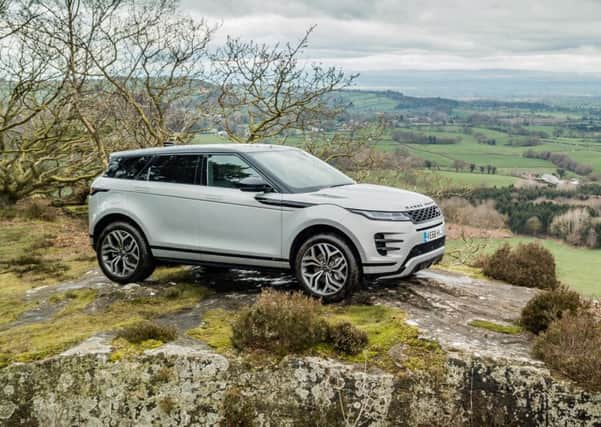Review: Range Rover Evoque


The good news is that it is better, giving the same feeling of, well, niceness I got eight years ago in the first Evoque. It is not much more expensive, starting at £31,600 for the 2-litre D150 diesel, with manual gears and front-wheel drive. Or, pay £4,120 down and £349 a month on a three-year contract. This is how 70 per cent of Evoques are “bought”. The attractive price plans are possible because the vehicle retains its value so well.
The rest of the range has all-wheel-drive, with a nine-speed automatic gearbox and a “mild” 48-volt electric hybrid boost which improves mileage and emissions by 6 per cent. All engines are 2-litre, four-cylinder units, peaking with the 300 horse power P300 petrol model. Model numerical designations are in metric horse power, with P for petrol and D for diesel.
Advertisement
Hide AdAdvertisement
Hide AdDiesel engines still account for 78 per cent of Land Rover and Range Rover sales. The maligned fuel gives more pulling power and better economy but it is worrying to hear that 73 per cent of Evoque owners live in towns and cities – which is one place where diesel toxins are not welcome. The same research shows that 70 per cent of Evoque owners do not have children.
Coming soon are Evoques with batteries which can be charged from the mains (PHEVs), which allows a measure of zero or very low emission driving in town. One in every two full-size Range Rovers inside the M25 are PHEVs – combining lower emissions and lower personal taxation. London’s new congestion zone starts on 8 April when there will be an additional charge of £12.50 a day if your car is considered dirty. That means pre-2005 petrol engines and diesels before September 2015 will be taxed. By October 2021 most of the roads inside the north and south circular orbits will be included.
So, back to the nuts and bolts. There is a stack of new stuff on the Evoque. The interior displays, bar the entry model, move to touch screens, similar to the system in the Range Rover Velar. You select the measure of off-road traction you want on a screen. The old system used a more tactile rotary dial. A new automatic setting does the selecting for you. Ergo, you can forget the individual icons apart from the controlled hill descent, which allows the Evoque to tip-toe down ghastly slopes.
This Evoque introduces the world’s first vision of what is under the front of the car. It is intended for seeing over blind summits off-road, and the proximity of obstacles, maybe kerbs, in town. It wasn’t on the vehicles we tested on the Land Rover Experience course at Peckforton, Cheshire. We did try it on a section of hotel drive but it would not be high on my options list. Also offered is a more useful roof-mounted rear view camera which gives a wider angle than the regular interior mirror – which can have its view obscured by passengers or stacked-up luggage or a dirty back window. You can alternate the view in the mirror by flicking a switch.
Body styling is sleeker this time, eschewing the funky “off-road” front and rear of the original. It is even slightly better off-road with a quicker response and a deeper wading depth – now 600mm or two feet, which is more than 99 per cent of owners would need. The nine-speed automatic gearbox allows a very low first gear which is useful off-road. On-road, the car normally sets off in second gear.
The door handles pop out, Velar style, when the doors are unlocked. The system can be set so only the driver’s door unlocks. The major omission this time is the three-door model, which cost more than the practical five-door body. It was trendy at first but became a rare sight. The niche convertible has also been dropped, for the time being anyway.
The company has invested £1 billion in its production at the Halewood factory near Liverpool. It employs more than 6,000 people, with thousands more in peripheral jobs. The factory also makes the Land Rover Discovery Sport, available with seven seats, and currently the company’s best seller. Inverness is its UK sales hot spot.
Both cars come off the same production line. Parts are delivered “just in time” by DHL. It is a slick system, invented in the 1950s in Japan by Toyota and finessed over the years at carmakers in dozens of factories across the world.
Advertisement
Hide AdAdvertisement
Hide AdThe factory does public tours, £49 for a three-hour tour or £295 for a bespoke visit in which owners can meet their SUV as it progresses down the production line.
Verdict: A subtle, smart and comprehensive update for the champion.